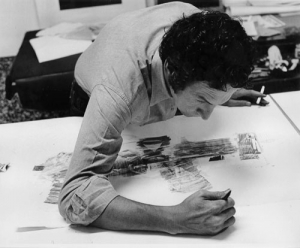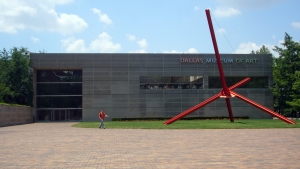|
Displaying items by tag: digitize
The Judd Foundation is working to digitize Donald Judd’s archive, which is in the process of being moved fr om New York to Marfa, Texas, wh ere the artist founded the Chinati Foundation in 1986.
The archive has so far been the main resource for a catalogue raisonné being compiled by the Judd Foundation. With the appointment in September of former studio assistant Ellie Meyer as the catalogue raisonné research manager, the project is moving into a more public phase, focusing on collectors, galleries and institutions.
How did Pablo Picasso celebrate his 80th birthday? Thanks to recent efforts by the Associated Press and British Movietone to make their newsreel archives more accessible to the public, we can now witness snippets of the occasion. The two companies announced a project to upload over one million minutes of digitized film footage to YouTube, comprising over 550,000 videos dating as far back as 1895. There are plenty of art-related clips to explore — watch New Yorkers in 1995 react to Christian Boltanski’s “LOST: New York Projects” in the subway or see Christo and Jeanne-Claude unwrap the Reichstag — but one of the greatest gems is the documentation of Picasso’s birthday.
On Christmas Day 1833, Charles Darwin and the crew of HMS Beagle were larking about at Port Desire in Patagonia, under the keen gaze of the ship’s artist, Conrad Martens.
The crew were mostly young men – Darwin himself, a recent graduate from Cambridge University, was only 22 – and had been given shore leave. Martens recorded them playing a naval game called Slinging the Monkey, which looks much more fun for the observers than the main participant. It involved a man being tied by his feet from a frame, swung about and jeered by his shipmates, until he manages to hit one of them with a stick, whereupon they change places.
The Walters Art Museum in Baltimore says it has digitized and catalogued more than 600 American paintings and other artworks, making them available for download and public use.
The new digital archive includes rarely seen works from John Singer Sargent, Mary Cassatt and John La Farge, among other artists. The museum said it used a $111,615 grant from the U.S. Institute of Museum and Library Services to pay for the project.
The New York City Department of Records and Information Services has added 30,000 historical photographs to its extensive online gallery. Among these images are over 2,000 photographs from the NYPD departmental files and Emergency Services Unit, dating from 1928 to 1941. The images depict everything from a plane crash in Brooklyn to Communist Party rallies in Madison Square Garden, a Nazi summer retreat in Long Island, and John F. Kennedy’s ticker-tape parade from the 1960 presidential campaign. The online gallery now boasts 90,000 photographs, the largest collection of New York City historical images in the world.
The never-before-seen pictures were scanned from vintage large-format film and glass-plate negatives, color transparencies, century-old lantern slides, 35mm Kodachromes, and prints in the Municipal Archive. The city plans to eventually digitize its entire collection.
The photographs can be viewed here.

The Roy Lichtenstein Foundation has announced that it will donate its remarkable Harry Shunk and Shunk-Kender Photography Collection to five major institutions -- the Getty Research Institute, the Museum of Modern Art, the National Gallery of Art, the Centre Pompidou, and the Tate. The collection includes approximately 200,000 black-and-white prints, color prints, negatives, contact sheets, color transparencies, and slides.
The Foundation’s donation is unique in that it will establish a consortium among the institutions that will both receive and share the materials. The collection of photographic material was shot by the late Harry Shunk and Janos Kender, and dates from approximately 1958 to 1973. Many of the images capture notable artists such as Christo and Jeanne-Claude, Robert Rauschenberg, Joan Miro, Cy Twombly, Andy Warhol, Man Ray, Barnett Newman, and Alexander Calder.
The photographs were acquired by the Foundation between 2008 and 2012, several years after Shunk’s death. The Foundation went on to preserve, catalogue and digitize the works, eventually creating a free online archive.

The Dallas Museum of Art announced an anonymous gift of $9 million to be spread out over the course of three years. The donation was made to ensure free general admission to the museum and enable the institution to digitize and ultimately publish its entire collection online.
The Dallas Museum of Art is the largest museum in the region and provides access to its collection as well as educational and public programming for the community. In January 2013, the institution implemented a free general admission policy in order to reflect its dedication to ever-increasing accessibility. The digitization of its entire collection will help the Dallas Museum further this particular goal. The images and data will be available to students, teachers and scholars under Open Access licenses for free personal and educational use.
Maxwell L. Anderson, the museum’s Eugene McDermott Director, said, “This is an exciting moment in the Museum’s history, and we are deeply grateful to our donor for the exceeding generosity and the significance of this gift. With this donation, the DMA will become one of the world’s most open and accessible museums. This opportunity reinforces our deep commitment to serve as an important educational resource for our local and regional community, as well as for our growing online audiences worldwide.”
New York’s Morgan Library & Museum announced that it will begin digitizing its renowned collection of master drawings next month. The goal is to create a digital library of over 10,000 images, representing drawings spanning the 14th to 21st centuries. The images will be free of charge through the Morgan’s website. The project is slated to reach completion within one year.
The images will be available for download for use in classroom presentations, dissertations and educational websites devoted to the fine arts. Each image will be linked to a corresponding catalogue record detailing the scholarly information related to each drawing. 2,000 of the drawings will include images of versos, which will show inscriptions by the artist.
William M. Griswold, director of the Morgan Library & Museum, said, “This project will provide access to the full range of the collection and is critical to our institutional goal of promoting drawings scholarship and reaching out to an ever larger audience.”

Washington, D.C.’s Smithsonian Institution, which is comprised of 19 museums and 9 research centers devoted to the “increase and diffusion of knowledge,” has seen an rise in troubles relating to their storage system. The Smithsonian currently has 130 million objects ranging from paintings and furniture to skeletons in their storage and maintenance facilities, many of which reside in damaged containers or poorly organized archives. During a recent audit, the National Museum of American History was allegedly unable to locate 10% of their collection.
The Committee on House Administration held a hearing on Wednesday, July 17th to discuss the challenges facing the care of the Smithsonian’s collections of art, archival footage and delicate objects. Smithsonian Inspector, General Scott Dahl, claimed that the institution is still employing poor storage space that was built in the 1950s and never intended for long-term use. A report from the Smithsonian’s inspector general in 2006 showed that not only were the storage facilities inadequate, but that security and inventory controls were lacking, leaving some of the country’s most precious treasures susceptible to theft or misplacement.
The Smithsonian has been working to fix their storage and maintenance issues for the past seven years and has invested $462 million in collections management and $390 million in facilities improvements. However, ongoing budget cuts have made fixing these issues once and for all, increasingly difficult. In addition, a large portion of the Smithsonian’s budget is currently being used to digitize the museum’s collection, which could take years.
Baltimore’s Walters Art Museum, which houses a vast collection of paintings, sculptures, art objects, and artifacts from around the world and throughout the ages, has joined forces with Stanford University Libraries to digitize its medieval manuscript collection. The Walters plans to make the works available online and has reached an agreement with Stanford Libraries to give over 100,000 high-resolution images of its manuscripts to the University’s Digital Repository.
While the original manuscripts will remain at the Walters Museum, the high-resolution images will be accessible to scholars around the world so that they can analyze the works and compare them with manuscripts in other locations.
The Walters Art Museum currently has 850 medieval illuminated manuscripts and 150 single leaves, which range in date from the 9th to the 19th century; it is one of the most significant collections of medieval manuscripts in North America.
|
|
|
|
|